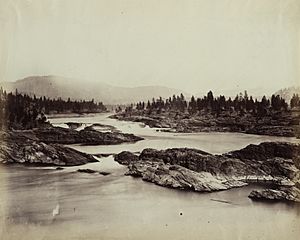Kettle Falls facts for kids
Kettle Falls was a very important place on the Columbia River in Washington State. It was a famous salmon fishing spot for many Native American tribes. The falls were near the Canada-US border.
The name "Kettle Falls" comes from the Salish words "Shonitkwu" or "Schwenetekoo." These words mean "roaring or noisy waters" or "Keep Sounding Water." This describes the loud sound the falls made.
Kettle Falls was made of many rapids and small waterfalls. The river dropped almost 50 feet (15 meters) over quartzite rocks. You could hear the sound of the falls from miles away! Sadly, Kettle Falls was flooded in 1940. This happened when the Grand Coulee Dam was built, creating Lake Roosevelt. The falls are now permanently underwater.
Contents
The History of Kettle Falls
For at least nine thousand years, early people called Paleo-Indians came to Kettle Falls. They gathered here to fish and find food. About two thousand years ago, people who spoke Salish arrived. Kettle Falls then became a major center for trade among many Native American tribes.
Fishing and Trade at the Falls
The economy of the area was based on salmon fishing. Native peoples traveled from the coast and the Great Plains to visit Kettle Falls. They came to fish, trade goods, and meet with other tribes from the Columbia Plateau.
Up to fourteen different tribes would meet at Kettle Falls. This happened regularly during the salmon spawning season, from June to October. People stood on rocks or on Indian Island in the middle of the falls. They used spears and special J-shaped baskets to catch fish.
Lawney Reyes, a Sinixt person, wrote about the falls. He explained that his people caught salmon that were not strong enough to get over the falls. This way of fishing helped make sure that only the strongest fish went on to lay eggs. This helped keep the salmon population healthy.
Early European Visitors
The first European to describe the upper Columbia River was David Thompson. He was a Canadian mapmaker and explorer. He arrived at Kettle Falls on June 19, 1811. He called it Ilth koy ape, which was a local name for the fishing baskets.
Thompson stayed at the falls for two weeks. He watched the native people fish and prepared for his journey downriver. He wrote that the village was a "general meeting place" for news, trade, and solving problems. The villagers often helped settle disagreements.
Later, in 1825, fur traders from the Hudson's Bay Company set up Fort Colvile nearby. A Jesuit priest named Pierre-Jean De Smet visited in 1841. He saw native people catching up to 3,000 fish every day! The Jesuits built St. Paul's Mission at the falls in 1845.
In 1891, a town called Kettle Falls was started by people from Spokane. They hoped it would become a big resort town with a fancy hotel. But the railroad did not go through the town, so it never grew very large.
The Flooding of Kettle Falls
Kettle Falls was flooded in 1940. This happened because the Grand Coulee Dam was built on the Columbia River. The dam created Lake Roosevelt. The water behind the dam rose 380 feet (116 meters). This flooded over 21,000 acres (85 square kilometers) of land. This land included the original town of Kettle Falls and important areas where Native Americans lived.
A Ceremony of Tears
In June 1940, many people gathered to mourn the loss of the falls. Between 8,000 and 10,000 people attended a "Ceremony of Tears." This event was organized by the Colvilles. Representatives from many other tribes were also there. These included the Yakama, Spokane, Nez Perce, Flathead, Blackfeet, Coeur d'Alene, Tulalip, and Pend d'Oreille tribes.
Native burial grounds on Indian Island had to be moved. The town of Kettle Falls was also moved to its current location.
Impact on Native Life
The Grand Coulee Dam also blocked anadromous fish from swimming upstream. These are fish like salmon and steelhead that live in the ocean but lay their eggs in fresh water. This stopped salmon migration in the upper Columbia River Basin forever.
The loss of Kettle Falls, along with other falls like Celilo Falls, changed the traditional way of life for many native cultures. Their lives had revolved around salmon fishing for thousands of years. Many native people moved away from the area. However, others still live on the nearby Spokane and Colville Indian Reservations today.
The Confederated Tribes of the Colville Reservation sued the United States government. They settled the lawsuit in 1994 for $53 million. They also received $15.25 million every year starting in 1996.
The Third Powerhouse Project
In the late 1960s and early 1970s, the Grand Coulee Dam was made bigger. A new group of generators, called the Third Powerhouse, was added. During this time, the water level of Lake Roosevelt was lowered a lot in the spring. This is called a "drawdown."
The biggest drawdowns happened in the springs of 1969 and 1974. During these times, Kettle Falls was partly exposed again. These drawdowns also allowed the Lake Roosevelt National Recreation Area and the United States Bureau of Reclamation to do important work. They carried out a major project to save Native American and historical sites. These sites had been flooded by Lake Roosevelt.



